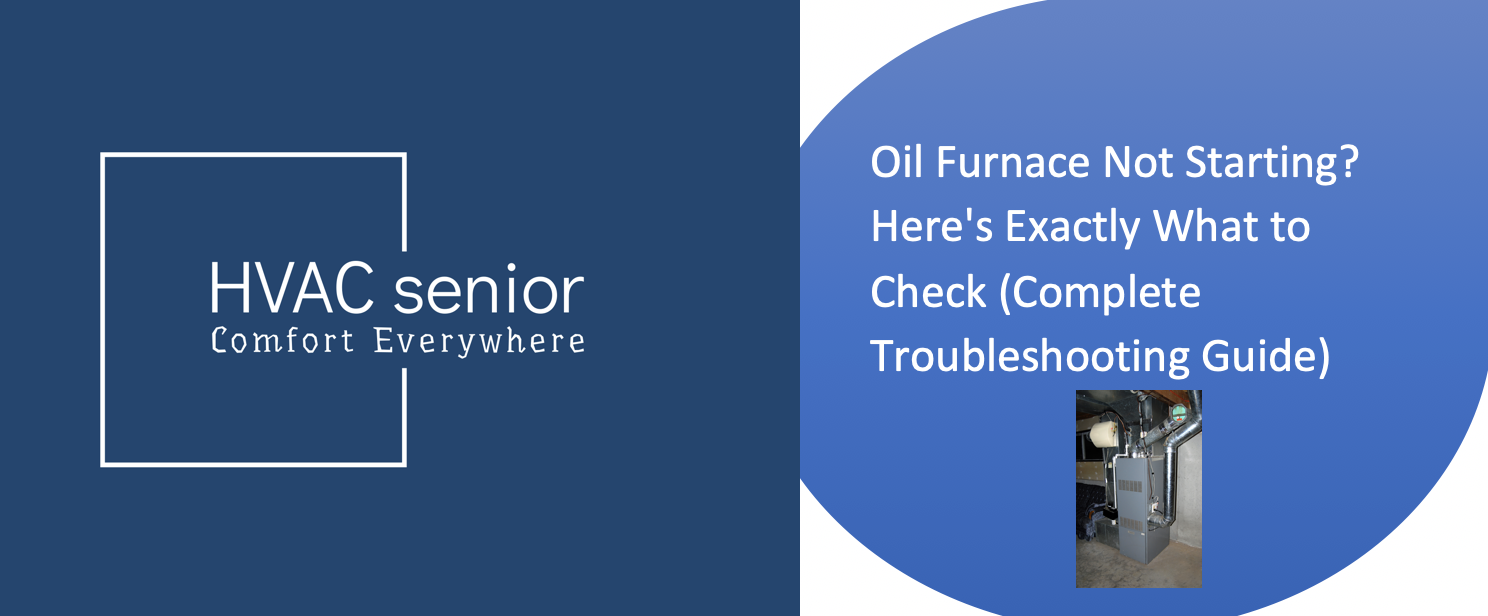When the temperature drops, the last thing you want is to find that your oil furnace won’t start. You head to the thermostat, crank up the heat, and… nothing. No humming, no clicking, no warm air — just silence.
Don’t panic. An oil furnace that won’t start can be the result of something as simple as a tripped switch or a dirty filter — or it may indicate a more serious problem like a faulty ignition or burner problem.
Throughout this guide, we will walk you through the most common causes of an oil furnace not starting, what you can safely check yourself, and when it is time to call in a professional.
Understanding How an Oil Furnace Works
It is useful to know the general process before actually starting troubleshooting.
- Thermostat calls for heat.
- The oil pump delivers fuel from a tank to the burner.
- Ignition system ignites the oil mist in the combustion chamber.
- The blower motor circulates warm air through the ducts.
If any one of these steps fails — thermostat signal, fuel delivery, ignition, or airflow — your oil furnace won’t start.
Also read: Furnace Not Heating
⚙️ Top 10 Reasons Your Oil Furnace Won’t Start (and How to Fix Each One)
Let’s go step by step through the most common reasons an oil furnace fails to start and what you can do about it.
1. Thermostat Issues
The thermostat is essentially the “on” switch for your furnace. If it is not working, or not set correctly, your system won’t even try to start.
What to check:
- Be sure the thermostat is set to “Heat.”
- Increase the temperature setting to at least 5°F above room temperature.
- If it is battery-powered, replace the batteries.
- Check the display; a blank screen often indicates no power.
Fix:
Replace batteries in the thermostat or replace the thermostat itself, and make sure that the unit is connected properly. If it still won’t signal the furnace, then it may require professional recalibration or replacement.
2. Power Supply Problems
Your oil furnace needs electricity for ignition, the blower motor, and the fuel pump. A simple power interruption stops everything.
What to check:
- Look for the furnace power switch, which is usually a light switch near the unit. Make sure it’s ON.
- First, check your home’s circuit breaker panel for a tripped breaker.
- Inspect fuses if applicable.
Fix:
Reset any tripped breakers. If the breaker immediately trips again, do not force it-you likely have an electrical fault that requires a technician.
3. Emergency Shutoff Switch
Every oil furnace has an emergency shutoff switch, usually located at the top of the basement stairs or on the unit. Perhaps someone flipped this switch by accident: that’s why the furnace didn’t fire up.
Corrections:
Make sure the red emergency switch is ON. If, after flipping it, the furnace still doesn’t respond, proceed with troubleshooting.
4. Empty or Clogged Oil Tank
It sounds obvious, but an empty oil tank or clogged fuel line is one of the most common causes for a furnace not to start. Sludge building up in the tank may also block the oil filter or nozzle.
What to check:
- Look at the oil tank gauge: make sure that there is enough oil.
- If you just had a delivery, air could be trapped in the line.
Fix:
If your oil supply is low, order an immediate refill. If the tank is full and the furnace still does not start, then the fuel line or filter could be clogged and must be cleaned or bled professionally.
5. Burner Tripped Reset Button
Your furnace’s burner unit is equipped with a reset button-a safety feature that shuts down the system if it finds an ignition failure.
What to check:
- Find the red reset button on the burner motor.
- Press it once only, to see whether the furnace starts.
Solution:
If the furnace starts and runs normally, great. But if it shuts down again, do not press the button repeatedly – this can flood the chamber with unburned oil, creating a dangerous condition. Call a technician.
6. Dirty or Clogged Air Filter
Poor flow might cause overheating of the unit or prevent the blower from operating, thus stopping the furnace altogether.
Fix:
Check and replace the air filter if it’s dirty. A dirty filter reduces efficiency and puts a strain on the blower motor. Replace it every 1–3 months during heating season.
Also read: Furnace Will Not Turn on With Thermostat
7. Faulty Ignition System or Electrode
If you hear the furnace running but it doesn’t ignite, the problem could be in the igniter or electrodes that spark the fuel.
Symptoms:
- Furnace motor hums, but there’s no flame.
- Burner cycles off shortly after start-up.
Solution:
Ignition components wear out over a period of time. They need to be tested and adjusted by a licensed HVAC technician to ensure proper spark and fuel atomization.
8. Blower Motor Failure
When the blower motor fails, the furnace may light but then shut down shortly thereafter because the system recognizes no airflow.
What to check:
- Listen for any humming or grinding sounds.
- Feel for vibration at the blower housing.
Correction:
Replace the blower motor if it seizes, wears, or overheats. Occasionally, replacement of a capacitor can restore functionality, but that is best handled by a professional.
9. Blocked Flue or Chimney
Oil furnaces create combustion gases that must vent through a flue or chimney. A blocked vent will prevent ignition or initiate safety shutoffs.
Fix:
Check the vent pipe for blockages from soot, bird nests, or other debris. Ensure that the damper is open. Perform only visual inspections — do not disassemble the flue yourself.
10. Safety Lockout or Limit Switch Activation
Modern furnaces are equipped with safety sensors that monitor temperature and airflow. If a sensor notices overheating or poor combustion, it will lock out the system to prevent further damage.
Correctness:
These safeties are usually reset by addressing the underlying cause of such overheating, blocked vents, or failure of the fan. These limit switches can be tested and safely reset by a professional.
Also read: Furnace Ignitor Lights But No Flame
Checklist of Step-by-Step Troubleshooting
Here’s a safe DIY sequence you can follow before calling for help:
Verify Power:
Check the switch and breaker, restore power if off.
Check Thermostat:
Set to HEAT and raise the temperature above room level.
Oil Level Check:
Confirm there’s fuel in the tank.
Press the Reset Button (Once):
If the system doesn’t start up, stop and call a technician.
Replace Air Filter:
Put a clean filter in its place for restored airflow.
Listen and Observe:
Do you hear the burner motor run? Any hum, click, or smell of smoke?
Call for Service:
If these steps don’t restore the heat, the problem probably involves ignition, fuel delivery, or internal electrical faults.
⚡ When to Call an HVAC Technician
If you’ve done all the basic checks and your oil furnace still does not come on, it’s now time to call a professional. A certified technician would:
Inspect the burner assembly and ignition system
Check oil pressure and fuel delivery
Clean or replace nozzles and filters
Test safety controls and electrical components
Bleed air from the oil lines if necessary
Calibrate the system for safe combustion
Attempting to make deeper repairs without the appropriate tools may aggravate the problem and create safety risks.
Preventive Maintenance Tips
Schedule annual furnace tune-ups before each heating season
Change filters regularly to maintain proper airflow
Keep the oil tank filled — never let it drop below one-quarter full
Clean debris or obstructions from vents and the flue
Listen for unusual noises such as squealing, banging, or humming that may indicate early issues
Check thermostat batteries twice a year
By investing a little in proactive care, you’ll save money, prevent emergency breakdowns, and keep your furnace running at maximum efficiency
❄️ Key Takeaway
If your oil furnace will not start, don’t think the worst yet. Begin with the most basic checks: thermostat settings, power supply, oil level, and filters. Often, these easy resolutions will have your furnace up and running in just a few minutes.
However, if, after pressing the reset button once or after all these checks, it still refuses to start, then it’s time for a professional inspection. A qualified HVAC technician will quickly pinpoint whether its an ignition issue, electrical problem, or fault in fuel delivery.
Knowing the potential causes and taking safe troubleshooting steps will ultimately get the heat back on sooner, prevent unnecessary repairs, and keep your home comfortable throughout the winter months.















